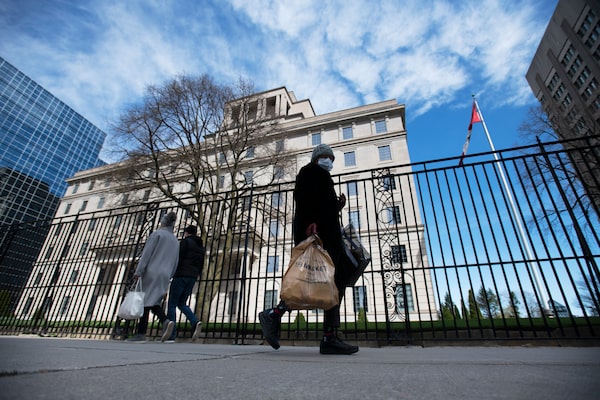
Manulife – its head office seen here on April 5, 2020 – reported that its first quarter net income fell by 41 per cent to to $1.25-billion, or 64 cents a share, compared with $2.13-billion, or $1.08 a share, in the first quarter of 2019.Fred Lum/The Globe and Mail
Although his company has seen profits tumble so far this year, Manulife Financial Corp. CEO Roy Gori says jurisdictions should not rush to reopen because another wave of COVID-19 could create greater economic and social devastation than the global economy has already seen.
Mr. Gori told shareholders dialling in to the company’s annual general meeting on Thursday that there needs to be a “dramatic increase” in the amount of COVID-19 testing globally, as well as progress in medical treatments and a vaccine before the “economy can safely return to some semblance of normalcy."
Already in China, which first began to experience lockdowns in mid-January, about 80 per cent of Manulife employees have returned to work, while Hong Kong is nearly at 50 per cent. Mr. Gori says he will be closely monitoring the Asian re-entrance as it has been a valuable region to learn from in how to handle the crisis.
Manulife has been hard hit by the pandemic, reporting Wednesday that its first quarter net income fell by 41 per cent to to $1.25-billion, or 64 cents a share, compared with $2.13-billion, or $1.08 a share, in the first quarter of 2019.
The steep drop in earnings was largely owing to market volatility and a sharp decline in oil prices, which created a $608-million loss on investments in the quarter. COVID-19 also hit Canada’s largest insurer with elevated travel insurance claims and lower insurance sales for certain products in its Japan market.
The company’s oil and gas exposure makes up 6 per cent of Manulife’s alternative long-duration assets, known as ALDA – a term for private non-fixed income. During a call with analysts on Thursday, Scott Hartz, Manulife’s chief investment officer, said while ALDA was a “significant drag this quarter," he expects to see significant recoveries when markets rebound.
“We do expect variability in our ALDA portfolio quarter-to-quarter due to its mark-to-market nature," Mr. Hartz said. “While oil and gas prices are stressed, we continue to believe these are high-quality assets and that our holdings will rebound in the medium-term when markets improve.”
One segment of the company that saw positive results was Manulife’s global wealth and asset management division, Manulife Investment Management. The business saw net inflows for both institutional and retail client assets of $3.2-billion in the first quarter, compared with net outflows of $1.3-billion in the first quarter of 2019. In Canada specifically, wealth management saw inflows of $2.8-billion for the quarter, driven by higher institutional sales.
The company’s shift into digital tools helped play a part in the asset manager’s ability to generate positive asset growth after Manulife received an exemption from regulators in Canada that allowed it to forgo in-person signatures as advisers cannot meet face-to-face with clients during the lockdowns, said Paul Lorentz, CEO, Global Wealth and Asset Management for Manulife Investment Management.
“While the behaviour of consumers and advisers had already started to shift to digital, [COVID-19] has really helped us advance the digital agenda much quicker than where we were,” Mr. Lorentz said in an interview with The Globe and Mail.
He also said the current environment provides opportunities to accelerate certain growth strategies, particularly in global wealth and asset management through acquisition. Last month, the asset manager acquired a 49-per-cent stake in Mahindra Asset Management, a financial services company based in India.
Both Manulife and its competitor Sun Life report earnings measures that exclude some costs, because they argue the measures are useful gauges of their operating performance. One exclusion is the effects of changes they make in underlying actuarial assumptions, such as how long customers will live for the life insurance policies the companies have sold.
Another example – which came into play in the first quarter – is losses in the stock market.
Manulife reported what it refers to as “core earnings" of $1.0-billion, or 64 cents a share.
This total excludes the $608-million loss on investments in the quarter, as well as an additional $1.3-billion loss tied to the equity markets and guarantees on its annuity products. Those losses were mostly offset by a $1.7-billion positive interest-rate impact as the company reassessed the liabilities tied to the insurance policies its customers hold.
Manulife’s Asian arm, which operates in 12 regions, experienced a steep 86-per-cent drop in profits, year over year – largely owing to a change in investment regulation in the Japan market. Net income for Asia was $95-million for the first quarter, down from $695-million in 2019.
Your time is valuable. Have the Top Business Headlines newsletter conveniently delivered to your inbox in the morning or evening. Sign up today.